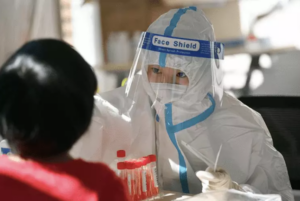
Zhang Wenhong: Omicron has multiple subtypes of strains, and the first batch of vaccines can hardly prevent re-infection
The Sino-US High-End Forum on Clinical Microbiology and Infectious Diseases was held online + offline on December 17.

Conference site.
With the relaxation and optimization of national epidemic prevention and control policies, domestic neo-crown infections have seen a wave of peak. The relevant experts from China and the United States at the conference discussed the difficulties and countermeasures in the prevention and control of neo-crown epidemic and the possible changes of neo-crown virus in the future. Participating in the discussion were Professor Xu Yingchun from Peking Union Medical College Hospital, Professor Zhuo Chao from the First Affiliated Hospital of Guangzhou Medical University, Professor Qi Chao from Northwestern University Memorial Hospital, Professor Zheng Xiaotian, Director of Microbiology Department of Akron Children’s Hospital, and Professor Zhang Wenhong, Director of Infection Department of Huashan Hospital of Fudan University and other experts in related fields.
According to Zhang Wenhong, there are multiple subtypes of Omicron virus, and it is possible to infect one subtype and then another subtype. Eventually, it may have seasonal infection as well as regional infection, just like influenza virus. After the human body is infected with multiple virus subtypes, the virus eventually declines in virulence under the pressure of the body’s immune memory. The first subvaccines currently administered to the domestic population are from the original virus strains, and after multiple mutations of the virus, the protective effect of the vaccine becomes weaker and weaker, making it difficult to prevent reinfection with new coronaviruses. According to the experience of epidemic prevention and control in the United States, the infection of other viruses in addition to the new coronavirus cannot be ignored, and the infection rate of influenza or other viruses will increase after the infection rate of the new coronavirus comes down. At the same time, we have to track the mutation of the virus. At present, the mutation of the virus is mainly concentrated in the RBD region of the virus, and there is no phenomenon of virus recombination, but we have to keep enough attention to this.
The experts at the meeting made some targeted suggestions on the prevention and control of the epidemic, taking into account their own fields. Prof. Yingchun Xu believes that the mutation of new coronaviruses should continue to be monitored; in the post-epidemic era, the medical resources currently laid out can be used not only for the detection of new coronaviruses, but also to identify and diagnose more risks; and the protection and attention to critically ill patients should be strengthened.
Prof. Xiaoming Yin believes that long-term and continuous attention should be paid to virus mutations; the current mutations in new coronaviruses are point mutations; in the future, if new coronaviruses appear to recombine between different viruses like influenza viruses, their pathogenicity will change dramatically; since vaccine immunity lasts for a short time and breakthrough infections can occur between different strains, it is recommended to develop non-immune types of broad-spectrum antiviral drugs; and should antigen testing should be strongly promoted.
Prof. Qi Chao believes that future changes in new coronaviruses should be considered in conjunction with external screening pressure, and that the higher the screening pressure the less severe the symptoms caused by the virus will become. Prof. Zheng Xiaotian also suggested the need to pay attention to the occurrence of multisystemic inflammatory syndrome in children associated with neointimal pneumonia during the treatment of pediatric patients.
Experts at the meeting agreed that due to the constant mutation of the neo-coronavirus, it can infect the population repeatedly. Under immune stress, the virulence of neo-coronaviruses will continue to decline and may eventually resemble influenza viruses. The overall immunization of the domestic population is currently in depression, pending a second dose of booster immunization with the neo-crown vaccine. Meanwhile, the expert group suggested that co-infection with other viruses, such as influenza virus and respiratory syncytial virus, should not be ignored while detecting new coronaviruses.


Average Rating